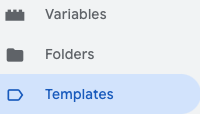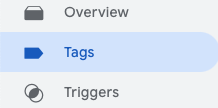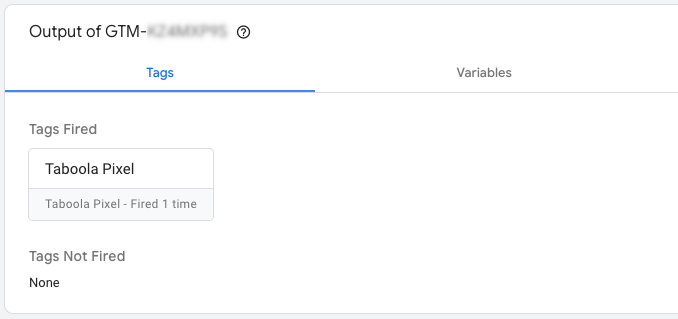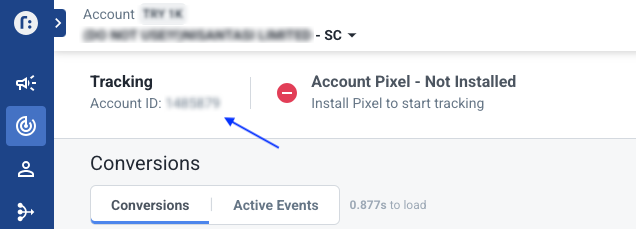Add the base pixel in Google Tag Manager (using a template)
Set up the base pixel in GTM (Google Tag Manager), using the Taboola Pixel template.
Overview
To add the Taboola base pixel in GTM using a template, refer to the instructions below.
Advantages of this flowNo need to work with code snippets - just fill in the form fields provided in the Taboola Pixel template.
See also
- For a list of available flows, see: The base pixel
- For an overview of conversion tracking, see: Conversion tracking
Shopify store owners should use our Shopify app.
Setup
First steps
If you have not already done so, open your Google Tag Manager workspace:
-
Open Google Tag Manager.
(You may be prompted to log in with Google.)
-
Under
Container Name(left), click on the relevant container.Note the
Container ID("GTM-XXXXXXXX") on the far right.(You can change your selection later, by clicking in the top, left corner.)
-
Select a workspace (top, left), or just use the
Default Workspace:
Containers & workspaces
- Containers (Official docs)
- Workspaces (Official docs)
Add the Taboola Pixel template
Taboola Pixel templateOnce you have opened your GTM container:
-
In the navigation panel (left), select
Templates:
-
In the
Tag Templatessection, click onSearch Gallery:
-
Search for a template called
Taboola Pixel.Make sure to select the
Taboola Pixeltemplate.Do not select the
E-Commerce Taboola pixeltemplate, unless instructed by Taboola. -
Select the template and click on
Add to workspace:
-
In the confirmation pop-up, click on
Add.
Add the base pixel tag
Once you have added the Taboola Pixel template:
-
In the navigation panel (left), select
Tags.
-
Click on
New(top, right):
-
Click on the
Tag Configurationcard. -
Under
Custom, selectTaboola Pixel.Tip: To shorten the list, click on the search icon
 (top, right) and type in
(top, right) and type in "Taboola". -
Fill in the
Taboola Account IDfor the account that you will use to create conversions.Tip: To find your Account ID, see: Tips & Techniques > Obtaining your Account ID (below).
-
In the
Tag Configurationcard, confirm that thePixel TypeisBase Pixel.When we set up conversion events, we will choose
Event Pixel. -
Click on the
Triggeringcard. -
Select
All Pages. -
Click on
Save(top, right):
-
When prompted, enter a descriptive name for the tag - e.g.
Taboola Base Pixel.
At this stage, your changes are not live - you still need to publish them.
Preview your changes (optional)
Although, you have added the tag within GTM, your changes are not live yet - you still need to publish them.
You can optionally preview (test-drive) your changes before you publish them. If you prefer to publish your changes immediately, skip ahead to the next section.
The
Publishaction will publish all recent changes - including changes made by other team members within this GTM workspace.
When to use preview
- Other team members are making changes in the same GTM workspace.
- You want to confirm your setup before you publish it.
- You want to test why a tag is not working as expected.
In your GTM dashboard:
-
Click on
Preview(top, right). -
Enter the URL of the page where the customer journey begins (e.g. the landing page). Then click on
Connect:- The Tag Assistant is opened in a new tab.
- If the connection is successful, your webpage is opened in a separate window.
-
Once a connection is made, click on Continue.
-
Review the
Outputwindow to see which tags were fired:
-
Click on the
Closeicon (top, left) to stop debugging:
-
Once you are done with the Tag Assistant, close the browser tab.
Publish your changes
The
Publishaction will publish all recent changes - including changes made by other team members within this GTM workspace.
- Click on
Submit(top, right). - Review the
Workspace Changes.This is the set of changes that will be deployed.
- (Optional) Enter the following fields:
Version Name- e.g."Taboola Base Pixel"Version Description- e.g."Added the Taboola base pixel".\
The above fields can help when reviewing a history of changes to your GTM container.\
- While you wait for GTM to publish your changes, sing like no one is listening :)
- Once published, a summary page appears.
What's next?
Well done - you have added the base pixel using GTM!
Next...
- Verify that the base pixel is running smoothly.
- Add event pixels
and verify that they are running smoothly.
- Alternatively, add URL-based conversions.
and verify that they are running smoothly.
Tips & techniques
The sections below contain different tips & techniques that can help with your integration.
Obtain your Account ID
To obtain your numeric Taboola Account ID:
-
Open Realize, and select the account (top, left) that you are using to track conversions.
Make sure to select the Taboola account that you are using to track conversions.
-
In the sidebar (left), select
Tracking. -
Copy the numeric
Account IDon the screen (top, left):
Additional info
Basic terms
- Taboola pixel - a Taboola code snippet that tracks user activity and gathers information about browsing behavior.
- Tag - (aka marketing tag) a code snippet that collects data from your website - e.g. Taboola pixel.
- GTM (Google Tag Manager) - a dashboard provided by Google to manage your tags.
Allows you to add, remove, disable and test-drive tags.
- GTM container - A collection of your tag definitions in GTM.
(You can create multiple containers.)
- GTM container code - A Google code snippet that injects all tags from your GTM container into your web page.
GTM resources
- Get started with Tag Manager (Official docs)
- Set up your Google tag (Official docs)
- Google Tag Manager ID (aka Container ID) and how to get it (An in-depth tutorial for beginners)
Updated 4 months ago
